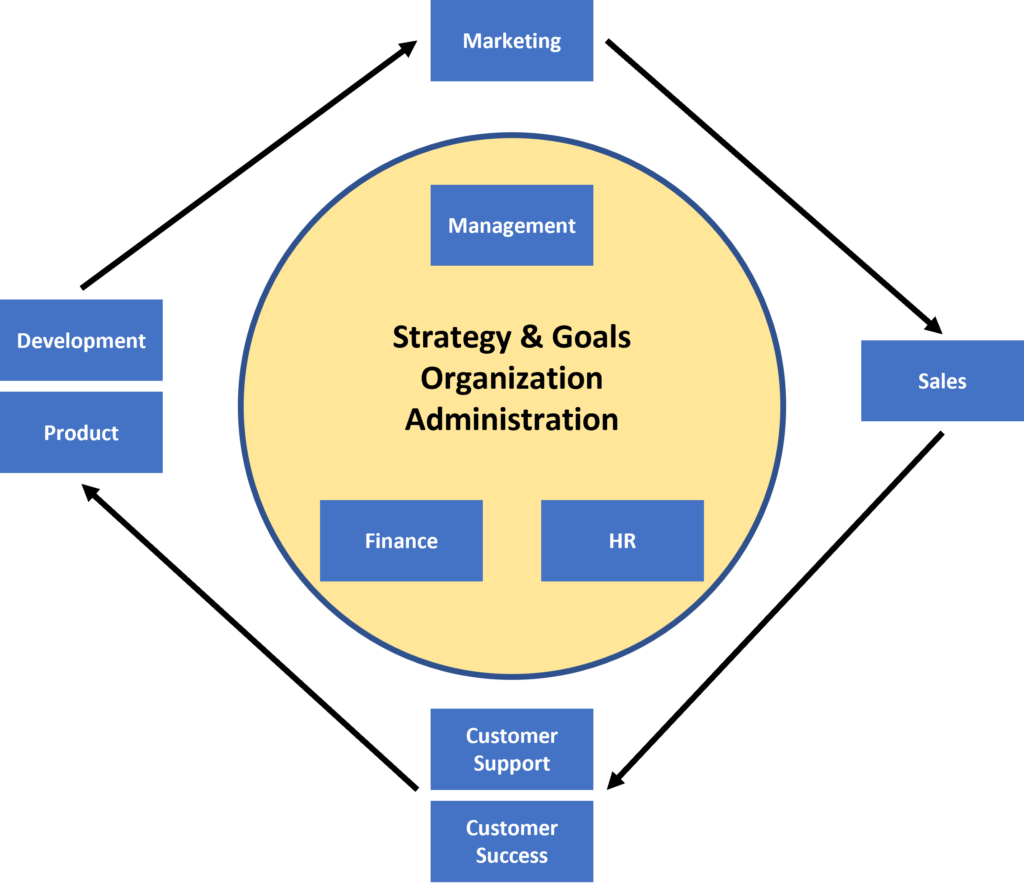Once companies have reached a certain size, the term “thinking in silos” can be heard more and more often. Individual teams work in their own closed world, then present accomplished results to the other teams and end up wondering about astonished faces and lack of support or even open resistance in the worst case. Of course, this creates extreme annoyance on all sides, which in turn leads to even more silo thinking. The classical example here are certainly development teams that come up with products and features that no one needs in the end. But there are also sales teams that promise everything to the customer and then can’t deliver because there was no agreement with the product team. Or who doesn’t know the marketing teams that do a super job generating thousands of leads, but then no one follows up on them or they simply don’t convert into sales in the end.
It starts with the graphical representation of the organization
How do we represent organizations today? In most cases like in this organization chart:

The representation alone shows nothing but individual silos. Sure, this does not mean, that this is the first and only reason why teams often lose sight of the big picture. But the larger organizations become, the more such an organizational chart also represents the reality. In extreme cases, individual team managers even prohibit employees from communicating across teams because everything needs to be worked out on the management level. Fortunately, the latter is rather the exception today, but can still be observed here and there.
Is the customer really at the center?
Ultimately, every company is about winning new customers, retaining them for as long as possible, and ideally turning them into true fans who in turn attract new customers through their recommendations. But is this really always in the mind of every single employee in every team? The sales team might immediately come to mind as the one, which has internalized all of this. But does a sales employee really care whether the customer remains a customer for as long as possible if commissions are only paid for new business? On the other hand, feedback from the customer is often perceived as “annoying” by the product team. After all, they have put a lot of thought into product design and you actually can’t please everyone. This may sound a bit exaggerated, but it is not uncommon in reality. The interests of the individual teams do not always fit with what the customer wants or needs.
The organization must revolve around the customer
Every company needs organization, administration and, last but not least, a management that sets the strategy and the goals. These must be at the center, so to speak, and ensure that everything “runs smoothly”. A product or service can only get better by constantly incorporating feedback from the customer and from the market. In many companies, customer support is only used as a problem solver. Of course, this is the primary task of the support team and plays a significant role in determining whether a customer remains loyal in the end. The image of a company is also often determined by the quality of its customer support. But with every inquiry the support team receives important information about general customer satisfaction and product quality. Companies that want to take advantage of this proactively build Customer Success teams that contact existing customers to inform them about news, gather feedback and, of course, ideally sell more products or upgrades. In doing so, you get valuable information to improve your product and ideally avoid that customers are quietly moving to the competition. At least you get the opportunity to prevent the latter. And if you can’t prevent it, you hopefully understand why the customer decided otherwise and you can pass that valuable feedback back to the product team.
A new organization chart
Shouldn’t an organization chart therefore look more like this?

As mentioned previously, an organization chart alone will not change the behavior of employees and teams. Depending on the size and nature of the company, things may also be a bit more complicated. But I’m also aiming here more at startups and smaller organizations that are growing fast and where the founders have the challenge of transferring more and more responsibility, especially for day-to-day operations, in order to focus on the strategic needs of the company and ensure that silo thinking doesn’t develop in the first place. You can’t start with that early enough.

